Friday, May 15th, 2020 by Julian Karsunky
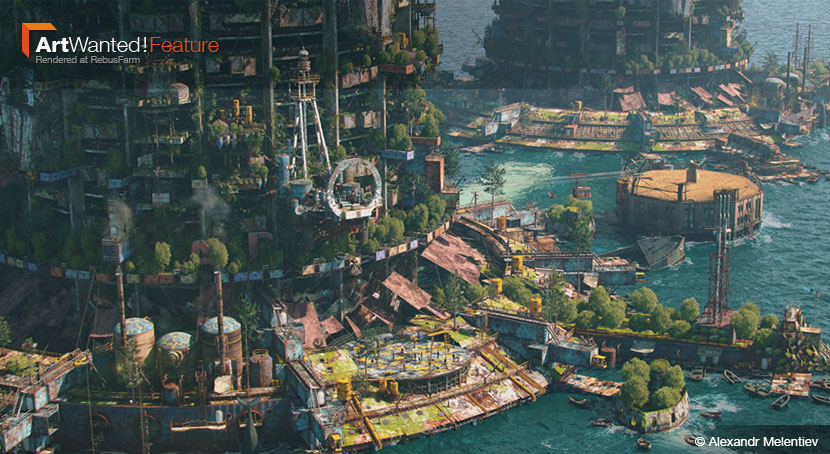
This month’s ArtWanted! feature sees the return of a familiar face! Those in the know might immediately recognize Alexandr Melentiev's signature style upon looking at the incredibly detailed floating cityscape pictured above. His holistic approach to worldbuilding is a prime example of visual story-telling: his dense designs are reflections of elaborate and meticulously developed narratives, with even the most seemingly random elements serving a clear and previously defined purpose. The Russian 3D generalist has kept busy these last two years, perfecting his craft, one world at a time.
Check out our interview to find out, how deep the rabbit hole goes and learn more about Alexandr’s glorious return to CGI after a prolonged hiatus.
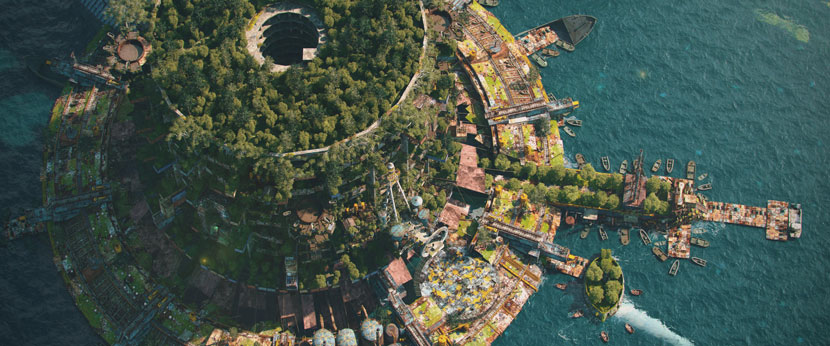 The vertical design of Alexandr Melentiev’s ‘City on the Water’ is not only due to the limited space available, it also resembles the hierarchical structure of its society.
The vertical design of Alexandr Melentiev’s ‘City on the Water’ is not only due to the limited space available, it also resembles the hierarchical structure of its society.
Hi Alexandr, we’re thrilled to have you back, it’s been a while! For those who missed our last interview, please introduce yourself once more!
Hello! I’m Alexander Melentiev, a 3D generalist offering a variety of services from concept to final composition, though I mainly specialize in creating environments. Lately, I have been creating city design for films and TV shows. I also work in advertising and movies, for which I shoot myself. While I do a lot on my own, I closely collaborate with Red Module Studio, a team of very capable specialists.
What have you been up to these last two years? Can you bring us up to speed on how life has been treating you, both privately and professionally?
Two years passed quickly! Since we last spoke, I relocated to the city of St. Petersburg, Russia. I no longer do interior design – instead, I focus all my efforts on CGI exclusively. At the moment, I do a lot of contract work for studios all over the world, but I still operate as a freelancer, which I very much enjoy!
What have you been working on recently? Are there any projects you’d like to mention that stood out to you?
Let’s see, I worked on the filming of a Chinese film in Beijing as a supervisor. In the last year, I was involved in several Russian films, the most well-known one probably being Koma. Design work for movies is very interesting, to say the least! There are quite a few recent projects that I’m excited about, but unfortunately, I can’t disclose any further information as of now due to contractual obligations.
How are you holding up in these trying times? How has the current crisis impeded your work?
All in all, I think my workload has actually increased during the crisis. With larger studios on lockdown, generalists are highly sought after right now. And while we’re not able to film on location for obvious reasons, we can still draw, model and animate!
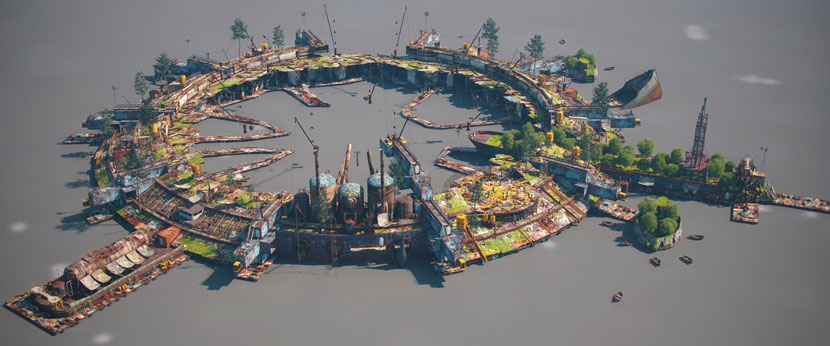 Home to fishermen and other common folk, the lower city encircles the more valuable greenhouses and growing facilities.
Home to fishermen and other common folk, the lower city encircles the more valuable greenhouses and growing facilities.
Last we spoke, we took a deep dive into your approach to visual story-telling and world-building. Looking at your portfolio, you certainly have been busy crafting all sorts of intricate set pieces. How do you keep coming up with new and fresh ideas and settings?
Every idea starts as a basic thought. Inspiration can come from anywhere, from nature, from music, from paintings by other artists. Any small detail can push my imagination in unexpected directions. I browse ArtStation a lot, I check out the work of fellow CG artists each and every day – not only to keep up to date, but because I find it inspiring! Sometimes, when I look at an image, I think: “wow, this is so cool!”, and it motivates me to come up with something equally cool in turn.
A lot of your artwork features futuristic and fantastical cities and settlements. What makes you come back to that particular aesthetic and subject?
Once upon a time, I enrolled at Ivanovo State University of Architecture and Civil Engineering (IGASA). There, I saw drawings of cities. It looked complex, very confusing and very difficult, but at the same time, it made me want to learn to build cities myself. However, when I left the university, I went straight into work, and couldn’t pursue this ambition further. Looking back now, I think this was most likely the catalyst for my current enjoyment in coming up with all kinds of cityscapes.
To better describe your unique style, you coined the term “wooden punk”. Lately, I’ve also seen you attach the world “(Russian) king punk” to some of your works. Have you further developed this concept? Please explain the difference between the two!
At first, before I had really developed the idea, I used “wooden punk” to simply refer to my work, as I made everything from wood, frequently combined with steampunk aesthetics. Over time, it became more though: in Russia, wood has a long history as a construction material, so there already was a link there. Since very few artists develop the Russian style, I decided to go further in that direction, drawing on my cultural heritage and incorporating more and more elements from Russian folklore and architecture to my designs. Consequently, this “world” of mine has now become "Russian king punk."
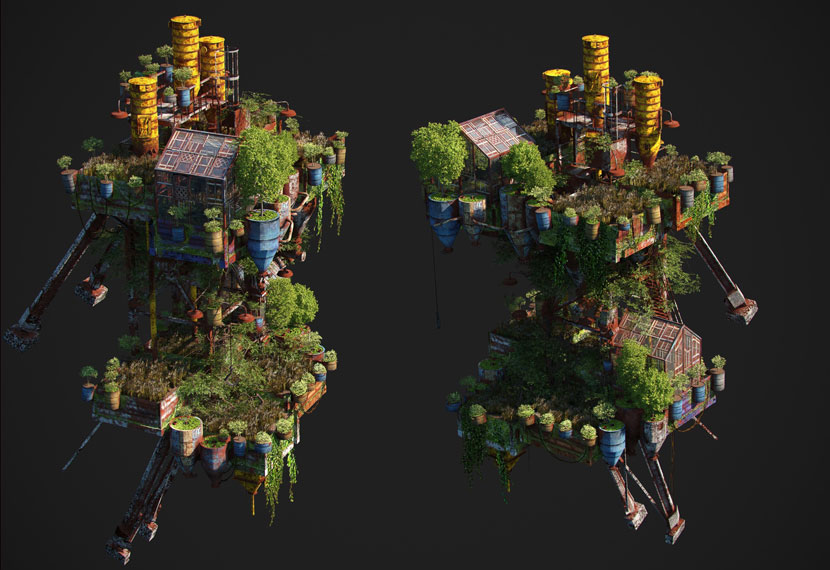 While not necessary to the enjoyment of his work, immersing yourself in the lore of Alexandr’s work increases the experience greatly.
While not necessary to the enjoyment of his work, immersing yourself in the lore of Alexandr’s work increases the experience greatly.
Let’s talk about your work in more detail, namely the ‘City on the Water’ you submitted to our campaign. This was your submission to render.ru’s "The End of Civilization" contest. Can you first tell us more about the competition, its rules and guidelines and your motivation for entering?
According to the rules of the competition, it was necessary to come up with an apocalyptic cityscape. Several scenarios were suggested: during the apocalypse, life after the apocalypse, and so on. I chose to depict the aftermath, since it seemed to me that this would be something very stimulating to think about, to figure out how people would live.
Now, for my motivation, that is a rather unusual story. You see, I had left the CGI industry for eight years, during which I worked as an interior designer. Eventually, I decided to come back, and this contest was the perfect opportunity to announce my return with a bang!
Was there a particular reason you imagined a flood catastrophe as the cause of your post-apocalyptic scenario?
I thought that everyone would either make use of a ‘Mad Max’-like desert setting or show cities overgrown with plants. Since I wanted to do something different, I thought a deluge would be a good idea. With everything flooded all around, only the tops of the skyscrapers would remain above water, which I felt would make for an interesting visual and starting point for my design.
Let’s dig a bit deeper, as I know you once again came up with an elaborate backstory for this swimming garden city and the society it houses… Please tell us all about it!
This is a rather long story, so I’ll try to tell you briefly. At first, there was a general idea, which I expanded and fleshed out piece by piece. I started by asking myself: “who would survive the flood?” Well, those who have fruits and vegetables as well as water. Most likely the workers of some agricultural company will remain alive, as they have preserved plants and have the knowledge how to grow them even without land. The buildings of my city therefore had to be equipped with cultivation areas. The buildings themselves are made from scrapped containers that were on barges.
Over time, those who did not know how to grow plants turned into ordinary fishermen and began to live closer to the water. These fishermen have their own district, the slums. This lower city contains residential buildings, squares, diesel fuel stations and factories – everything that poses a threat for the vital vegetation. After many, many years, the people began to worship the scientists as priests of a cult of plants, who shut themselves off from ordinary people. Eventually, an altar appeared in the heart of the city. This altar, however, is also a brewery. You know how they say beer is the basis of civilization, haha.
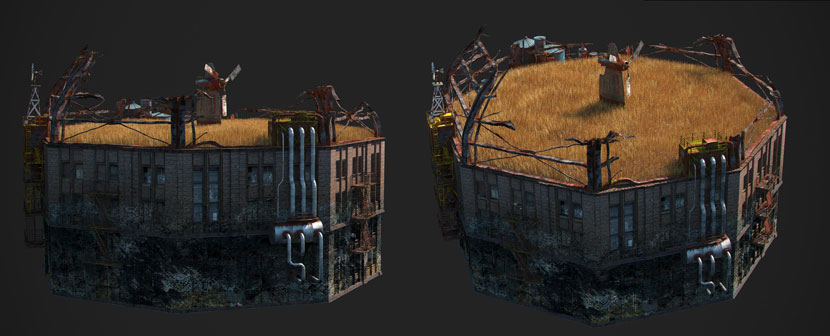 Be sure to check out more of the unique assets Alexandr created for his ‘City on the Water’ here.
Be sure to check out more of the unique assets Alexandr created for his ‘City on the Water’ here.
How does this backstory influence the design and vice versa?
First, the story always affects the design, and not vice versa, at least for me it does. For this project, I spent a lot of time thinking about how this city would be built, what it would look like and why. What people would need, how society would develop under such circumstances, who would be in charge and where would they live. Every inhabitant in this world has a purpose and a location. There’s a pier for the priests, on which there is a park, the entrance to which is decorated with drawings of foliage. There are drawings on the roofs of the lower city and painted glades with flowers, so that the priests would not be disgusted looking down there from above.
I thought about how they would collect rainwater and grow rice. How they needed greenhouses and whale oil processing plants. All of this required a ton of research on my part, I read a lot of articles on growing plants, on the design of ships and floating cities. Of course, I did not forget about the defense: there are catapults on the perimeter of the city.
It was necessary to think all of these small details through. Such as the trees in the lower city that sprouted from seeds falling from above, or the pipes from the sewer. There is a crazy miller living in a mill in a wheat field that is made out of an airplane wing. Visible in the distant, there’s a third island, another city, where the electricians live in subordination of the main city. On there, you can spot a tower that has "AM82" written on it, my initials and year of birth, haha.
What were some of the challenges you had to overcome? What parts of the image were especially important to you?
The hardest thing for me was to continue working on the city. I worked on this project every day for two to three hours over the course of three months, it certainly was tiring at times. At one point, I was sure I was just over it. I felt what I had was good enough and there was no need to continue further. Thankfully, my friends stepped in and motivated me to push onwards, they teasingly told me: "Now that you've done it badly, think about how to do it well."
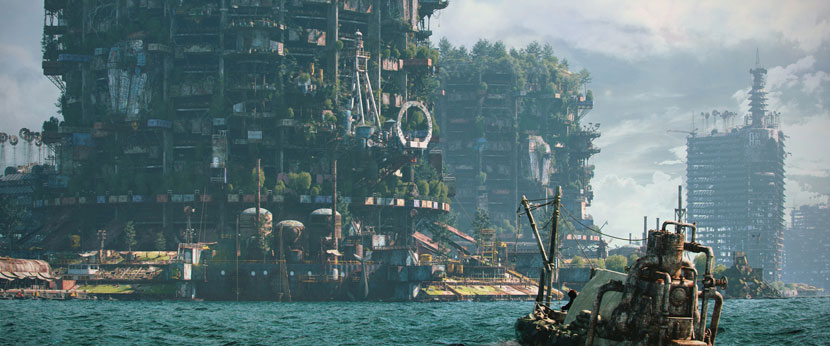 Kevin Costner, take notice! Alexandr knows how to design a ‘Waterworld’. You can see his cleverly hidden signature on the facade of the tower in the background.
Kevin Costner, take notice! Alexandr knows how to design a ‘Waterworld’. You can see his cleverly hidden signature on the facade of the tower in the background.
How satisfied are you with the results?
When I look back on it now, I think that I completed the city by 87%, I maybe should‘ve worked on it a little more. Still, I’m pleased with the result, I think it turned out cool! I especially love the lower city, I thought about that for a very long time. I immersed myself into it so much, I practically lived there for a while.
What software did you use to create the ‘City on the Water’? Any plug-ins you found particularly helpful?
I did everything in 3ds Max. For the water, I used Phoenix FD, and Speedtree for the vegetation. I rendered in V-Ray, for post-processiong I used Photoshop and After Effects.
What is some advice you would give to aspiring 3D concept artists? With almost every piece a whole new world – how do you effectively manage projects of this scope?
The single best piece of advice I can give, is to always ask yourself: "why?” “Why are things the way that they are? Do they have to be this way?” Maintain your curiosity, question everything, and, of course, never give up!
In closing, is there anything else you want to say? Any present or upcoming projects you’d like to mention?
These are difficult times. A lot of worrying things are happening in the world, and our industry is affected as well. I hope that this will pass soon and all of us can recover!
Regarding my projects, just follow my ArtStation, I’ll post exciting new images as soon as my NDAs end! Finally, once again thanks for giving me this opportunity, I hope I'll see you all at the international Art of 3D Graphics exhibition in St. Petersburg!
Sounds like we have a lot to look forward to! Alexandr, thank you so much for taking the time and all the best in the future!
Keep up with Alexandr Melentiev and his work here:
How to join ArtWanted!
You want to get featured in our ArtWanted! campaign and win 250 RenderPoints on top? Submit your work, rendered at RebusFarm, to This email address is being protected from spambots. You need JavaScript enabled to view it.! Visit our Art Wanted! page for more information.
>> Read more articles on our blog
